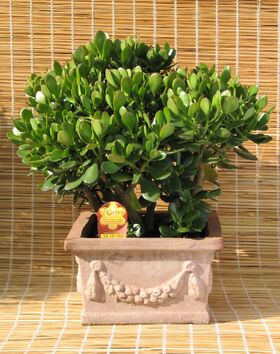
Crassula ovata
| Crassula ovata | |
| Classification | |
| Order: | saxifragales |
|---|---|
| Family: | Crassulaceae |
| Genus: | Crassula |
| Species: | Crassula Ovata |
| Growing | |
| Propagation: | From cuttings |
| Lighting: | Bright indirect |
| Watering: | Very little |
| Fertilization: | Frequent low strength |
| Soil: | Well drained |
| Air moisture: | Dry |
| Other information | |
| Toxicity: | Non-toxic |
Crassula ovata (common names: Jade Plant, Lucky Plant, Friendship Tree) is a succulent originating in southern Africa. One of the easiest houseplants to care for, Jade plants are commonly used as a beginner level Bonsai because of their resilience in dry conditions and supple new growth that is perfect for wire training.
Characteristics[]
The dark green fleshy leaves grow in pairs on opposite sides of the stem. The stem begins as the same texture and color as the leaves but as the plant develops it becomes firm and woody.
Fertilization[]
Fertilizing a succulent like the Jade plant can benefit from less than conventional methods. Most avid succulent growers tend to use a more frequent application of a very low strength fertilizer. A weekly application of fertilizer at 1/10 of the recommended dose is common.
Light[]
The ideal light conditions for a jade plant is bright indirect such as in a room with a uncovered South facing window or right in front of an East facing window with a sheer curtain.
Temperature[]
The Jade plant has a large temperature tolerance compared to many other plants. It does well with temperatures up to 90°F and down to 45°F. It can survive hotter temperatures but growth will halt at these extreme temperatures.
Multiplication[]
The Jade plant has a large temperature tolerance compared to many other plants. It does well with temperatures up to 90°F and down to 45°F. It can survive hotter temperatures but growth will halt at these extreme temperatures.
Pests and Diseases[]
Overwatering and associated rot is the most common problem that jades have in the home. Using a soil mix with a high volume of inorganic material in a pot with lots of drainage and reducing your watering schedule is the best remedy. Mealybugs sometimes infest this plant, look for the fluffy white residue and honeydew on it.
Potting[]
An unglazed ceramic pot is the best choice for succulents, ceramic is porous and will allow the soil to breath. Unglazed ceramic also absorbs some of the moisture and can help control overwatering by doing so. For the medium you will need a high content of inorganic material such as crushed pumice and a organic component like composted bark, finally you will need perlite or vermiculite to loosen the mix and increase drainage potential.
Washing[]
To clean your plant of dust accumulations that can affect its ability to capture sunlight place it in the kitchen sink or bathtub and use the spray attachment in your sink or the showerhead to clean the leaves and stems.
Watering[]
Watering requirements are minimal and misting should be avoided as it can spur the growth of mold. Placing the pot in a tray of water and allowing moisture to leech up through the drainage holes is the recommended method for watering many succulents including the Jade.
References
How to Care for Your Indoor Succulents